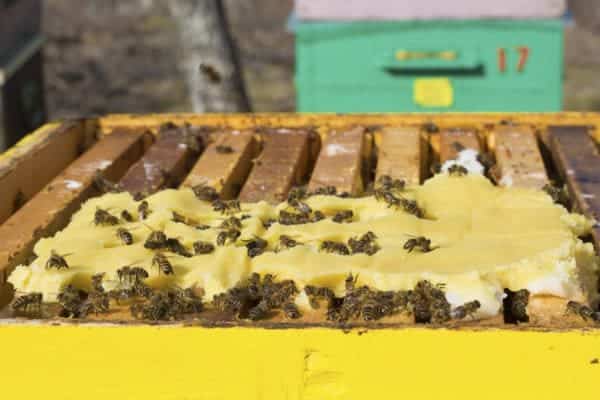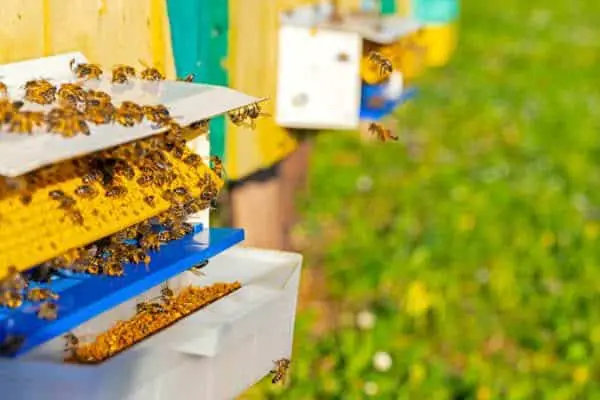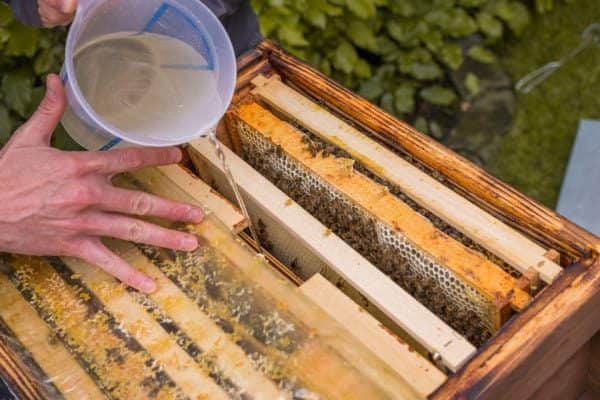Like any other living creature, bees need food to live. They require carbohydrates, proteins, vitamins, minerals, and even water for survival and growth.
Apart from their daily energy requirements, a bee colony must store food for the winter season. Not only is the weather too cold for the bees to fly, but also fewer flowers are in bloom for them to collect nectar from.
We all know that bees produce honey, and we enjoy the delicacy, but, is this what bees consume?
What do bees eat? Bees eat nectar and pollen for food. Bees have specific diets depending on the bee’s age, species, and available food. Nectar provides energy for the bees. Pollen is a rich source of proteins and also supplies fats, minerals, and vitamins to the bees. If nectar is not available bees eat sugar from friut or even soda.
Nectar and pollen are perishable. Honey bees convert them into other forms suitable for long-duration storage. In this article, you will learn how the honey bees make and store honey, how they convert pollen into bee bread, other alternative food options for the bees, and much more.
Check it out to discover more about the bee’s diet.
How Do Bees Collect Their Food?
Bees are hardworking creatures which are very efficient in their job. Their pollinating power makes available the varieties of foods that we consume. We mostly see honey bees when they are foraging, which is their usual way of finding food and water.
They will fly up to 5 miles in search of pollen and nectar. In turn, the plants get pollinated, which enables them to bear fruit and seed.
How Bees Make and Store Honey
Honey bees gather nectar from flowers to make honey. Nectar is a sweet liquid secreted by flowers to attract insects and birds. A flower advertises itself to bees and other insects by way of its colorful petals.

Bees like flowers such as dandelion, blackberry, clover, citrus trees, apple, and many more.
You may wonder how they carry the food? The bees drink the nectar and store it in the crop, a second stomach designed to carry nectar. While in the crop, the nectar mixes with enzymes that change its PH and composition.
The bee can also feed on nectar, if hungry, or if in need of energy. Back at the hive, the bees regurgitate the nectar to young worker bees that mix it with enzymes and deposit it into a cell.
Here, it remains exposed to the air for some time to reduce the water content. The bees also quicken the process by fanning their wings on the open cells. This now thick low-moisture substance is called honey. The cells are then sealed with beeswax and stored for future use.

Nectar provides energy to the bees as they complete this physically demanding process. It also helps to maintain water balance in their diet.
Ever wondered how much honey a single bee can make? If you’re interested we have an entire article that covers this, it’s called, How Much Honey Does A Honey Bee Make In Its Lifetime?
How Do Bees Eat Pollen?
Pollen is a yellowish or greenish powdery substance from flowers and is a component of plant reproduction, mostly for seed development.
We have a article that goes into detail about this if you are interested? It is called, How Do Bees Pollinate?
Pollen sticks to the bees’ hairy bodies as they move from one flower to the other. They then transfer the pollen into pollen baskets (corbicular) situated on their hind legs. They also spread pollen to different plants and flowers.

Pollen is one of the richest natural foods that contain all the nutritional requirements of a bee. It provides proteins, lipids, vitamins, and minerals to the bees.
Honey bees mix pollen with nectar and other secretions from their glands to make beebread, protein-rich food in which they feed the larvae. The secretions induce a fermentation process, which makes the bee bread more digestible and less perishable.
Bee pollen is stored in brood cells and sealed with a drop of honey. Nurse bees as required consume the pollen mixed with nectar, also known as bee bread, to enhance their hypopharyngeal glands to secret royal jelly.

Amazingly, pollen is also harvested alongside honey as human food and is thought to have many health benefits though they are yet to be scientifically proven.
What Do Queen Bees Eat?
Queen bees are fed with royal jelly. Royal Jelly is a white substance secreted from the hypopharyngeal glands of young female worker bees. It contains dietary supplements, proteins, sugars, B vitamins, fertility stimulants, among other minerals.

Queen larvae consume royal jelly throughout their developmental stage and for the rest of their lives.
The food makes the queen bees grow rapidly, double the size of an ordinary bee due to its rich nutritional value. It helps in the development of ovaries, large mandibles, food glands as well as wax glands.

Royal jelly also increases the lifespan of their lives. Surprisingly, queens can live up to five years and can lay about 2000 eggs each day.
What Do Workers and Drones Eat?

As larvae, they feed on honey, nectar, and pollen in the form of bee bread. Once a young adult worker reaches the age of a forager, she is incapable of digesting pollen and feeds on honey and nectar only.

Drones are much bigger than the worker bees and can consume three times more. In times of food scarcity, the workers drive the drones out of the colony to preserve the available food. With the drones unable to enter the hive again, they soon die of exposure, starvation, or become a meal for a predator.

Honey Bee Larva Diet
All young bee larvae are fed with royal jelly during the first three days of their development, after which they are fed with bees bread.

This fermented substance eases the digestion of pollen proteins. As aforementioned, the queen’s larvae feed on royal jelly throughout the developmental stage.
New adult worker bees after emerging from their brood cells, eat large amounts of pollen to complete their development. It enables them to evolve necessary glands for feeding immature bees.
Do Bees Drink Water?
Bees need water to survive. They collect water when needed in the hive, but they do not store it. The bees use the water to dilute honey when making brood food. Water is also used for cooling the beehive on hot days.

Brood food contains 70% water. Bees cause evaporative cooling in the hive by fanning over a thin layer of water when the temperature is high. The requirements of water for a bee colony depend on the prevailing weather conditions.
During winter, stored honey crystalizes. The bees thin it out with water to make it consistent for consumption.
How Beekeepers Supplement Food for Bees
Honey bees store honey in the hives for food during winter and when there is a short supply of nectar.
Although these amazing creatures have adapted extensive processes for survival in times of scarcity, sometimes they need our help. It is advisable to monitor frequently the amount of stored honey in the hive during these seasons because when it is depleted, they can starve.
Bee colonies can be sustained for long periods with optimum populations by supplementary feeding.
Protein Supplementation – Pollen
Whereas numerous kinds of plants and animal products are fed to colonies to supplement the protein diet, none beats the pollen; their natural diet. However, certain protein foodstuffs will improve their nutrition and enhance continued colony development in times of shortage.

An example of these foods is wheast. This is a combination of soybean flour and some brewers’ yeast products. Wheast is palatable to bees and also contains quality proteins required for the development and reproduction of the colony.
Due to its large particle size, it is fed as a moist cake inside the beehive. The type of sugar for making the cakes should allow their consistency for a longer time when exposed to the relatively warm and dry environment in the hive.
Some types of sugar may cause the cake to become hard in a few days. The best choices include sucrose and isomerized corn syrup.
The addition of pollen patties to the supplement food improves palatability and the number of nutrients required by the bees.
You should avoid using pollen substitutes from unknown sources to prevent exposure to infection. A good pollen substitute should be palatable, digestible, and balanced with the right proportions of amino acid and crude proteins.
Examples of commercial pollen substitutes for honey bees include Feed-Bee, Ultra Bee, and Bee-Pro.
Another option entails trapping bee pollen using pollen traps. Pollen traps are devices that are placed in front or under the hive, with holes that only allow a bee to get through without any load.

A bee loaded with pollen will have to offload the pollen first to be able to get through. The collected pollen is mixed with sugar syrup and fed to bees in times of scarcity.
Carbohydrate Supplement – Sugar Water
Whenever the honey supply in the hive is low, and the nectar in the field is scarce or inaccessible due to cold weather, beekeepers should supply the bees with a sugar supplement.
They can also keep some honey, which they harvest from the hives to feed the bees in times of scarcity. The best types of sugar include cane or beet sugar, isomerized corn syrup, and type-50 sugar syrup.
The syrups are provided in liquid form. The dry sugar or sugar syrup should be placed inside the hive in the evening to minimize the risk of robbing.
A starving colony should be fed with sugar syrup before dry sugar is given. This supplies the bees with immediate food. During summer, it is hard for bees to dissolve sugar crystals into liquid. At this time, a thin syrup is recommended 1 part of sugar and 1 part of water.

During winter, the syrup should be thicker. You may use 2 parts of syrup and 1 part of water. In this season, you are helping the bees to convert the syrup into stored food.

Bees do not have enough time to remove the water from syrup to make honey. A thick syrup will save their time and energy. Fondant and sugar candy can be supplied to the bees in winter if it is too cold for sugar syrup or in case of an emergency
Supplying Bees with Water
Lack of water affects the nutrition, physiology, and behavior of bees. A supply of water for the bees must be available at all times if a natural source is not within a half-mile radius or in times of starvation.
Other alternative sources of Food for Bees
Pollen and nectar are seasonal sources of food for the bees. When the supply of nectar is low, bees have been observed to eat and collect juices from overripe fruits such as peaches, plums, grapes, apples, and pears.

When there are no blooming flowers, they also feed on extrafloral nectaries from leaves and stalks of plants.
Honey bees also collect honeydew as a substitute for nectar, even if it is less nutritious. Honeydew is a sugary, thick fluid secreted by aphids and other insects that feed on plant sap. It is quite similar to nectar and is one of the natural alternatives for nectar.
When pollen supplies are low, bees can collect plant spores even though their nutrition value is lower than pollen.
They will also raid weaker colonies and steal their honey, especially during times of drought and famine. Other food choices include jams, sweets, and chocolates.

What Do Other Bee Species Feed on?
Bumblebees
Bumblebees feed on the same things as the honey bee. They collect nectar and pollen from flowers as their sources of food and also make honey.
Bumblebees are more effective pollinators due to their bigger body size. Their proboscis is also longer and can collect nectar from deep tube-like flowers.
If you ever see a bumblebee in distress there is a good chance to are out of energy. You can help them and we have an article that will tell you how to do that, Should You Feed Bumblebees? It Depends!
Carpenter Bees
Most people may think that carpenter bees feed on wood. The truth is that they too feed on pollen and nectar. Even if they are excellent pollinators, they become a nuisance by excavating on wooden objects while making their nests. They have short mouthparts and help to pollinate open-faced or shallow flowers.
Carpenter bees may not be eating the wood they are chewing holes in timber, often structural timber in your house. To find out more about what the carpenter bees are up to, check out this article we have written, How Do Carpenter Bees Drill Holes? It’s Worse Than You Think
If you have never heard of carpenter bees or you just don’t know much about them? Then we have written an article that would be worth a look. 16 Facts About Carpenter Bees You Need To Know
Mason Bees
Mason bees are solitary bees. The females lay eggs and die after ten weeks. During their short life, they feed on pollen and nectar but do not make honey or beeswax. However, they collect and store food reserves in their nests enough to feed young bees.

They store the food in cells one after the other, after which they lay an egg and seal up the cell. The process continues until the nesting chamber is packed with cells containing pollen, nectar, and an egg.
Once a larva hatches, he feeds on the food supply, which lasts for about ten days, after which the larvae spins a cocoon and pupates.

Mason bees are more effective pollinators than honey bees, mainly due to their messy nature and disperse pollen everywhere. Surprisingly the honey bees have a pollination rate of 5%, while mason bees have a rate of 95%. Mason bees do not create food stores due to their short life span, and the species overwinter as pupae.
Vulture Bees
Now vulture bees fit in the “believe it or not” category. Would you believe that vulture bees actually feed on rotting meat? Sounds crazy, doesn’t it. Well if you want to know the full story on vulture bees check out this article we have written, Vulture Bees: There Are Meat Eating Bees.
The Wrap Up
Honey bee colonies can get all the food resources they need to survive from flowers. Sometimes, factors beyond their control leave them hungry.
Aside from winter, other factors that may cause starvation to bees include climate change and deforestation. Pesticides sprayed on the plants can poison the bees as they collect nectar from the contaminated plants.
Studies show that when the bees are starving, they can even turn to toxic foods to survive, which may make them unhealthy and weak.
This is thought to be one of the leading causes of a decline in the bee population. Honey bee nutrition is crucial since it not only affects the honey production and survival of the colonies but also their role in natural food production.
Sources
https://en.wikipedia.org/wiki/Bee_pollen
https://carolinahoneybees.com/why-pollen-is-vital-for-honeybee-survival/
https://www.beesource.com/threads/honey-bee-nutrition-and-supplemental-feeding.365899/
https://www.ncbi.nlm.nih.gov/pmc/articles/PMC6075204/
https://www.nature.com/articles/srep31809
https://pollinators.msu.edu/resources/beekeepers/feeding-honey-bees/
